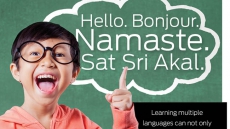The ‘We are Hockey’ exhibit showcases the history of people of colour making an impact in the sport.
On March 29, the University Of Fraser Valley’s South Asian Studies Institute (SASI) launched the ‘We Are Hockey’, a curated exhibition that will be available until February 2020 in the Sikh Heritage Museum, at the Gur Sikh Temple in Abbotsford. ‘We Are Hockey’ highlights historic racism and persistent racially-motivated inequitable representation within public representation in the game of ice hockey. The exhibit is a vibrant counter-narrative to the commonly held assumption that ice hockey is a ‘whites only’ sport.

The idea of the exhibit was born when Dr. Courtney Szto approached the SASI with her research findings regarding the troubling erasure of the history of people of colour in Canadian hockey. Dr. Szto’s PhD research then helped shape the idea into the creation of an exhibit, to challenge the notions of racial perspectives on hockey and bring the history of people of colour in the sport to the forefront. These unsung heroes have played major roles in the history of hockey; the evocative exhibit showcases a personal and collective history of Canadian hockey centered on the experiences of athletes of colour. Satwinder Kaur Bains, director of SASI and an associate professor with multiple published articles, hopes that “people come and broaden their horizons and understand that this is an iconic sport, but it has its dark history as well, and they understand our role to find a common humanity and to carry on the fight against racism and discrimination.”

The entire process – from planning, strategizing, designing, and organizing the event – has been about a year long. All throughout, the SASI received tremendous community support from the City, sponsors, schools, media and the Khalsa Diwan Society in Abbotsford. ‘We Are Hockey’ also includes historic timelines and wall biographies that highlight men and women of colour who have impacted the sport. The exhibit will also have a prominent Hockey Night in Canada Punjabi (HNIC) feature with the HNIC desk installed, where exhibition visitors can sit and get the feel of being a hockey presenter or take pictures at. In fact, HNIC Punjabi hosts Harnarayan Singh and Randip Janda, who are popularly known to have brought Punjabi language and culture to league-wide attention, were keynote speakers at the event launch.

The Sikh Heritage Museum pushes boundaries to engage with all communities. The exhibit’s scope into racism and hockey is a chance to engage with people from all backgrounds to show how people of colour have overcome significant obstacles to add to the history of Canadian hockey, in the face of obscurity from national attention and recognition. Sharanjit Kaur Sandhra, SASI coordinator and a PhD candidate with a passion for activism and community engagement, attributes her work with the Sikh Heritage Museum as having “instilled for me within a concept of seva. We are all collectively working towards selfless service to all our various communities so that we may showcase our history, heritage, and faith.”

South Asians in Canada have been ice hockey fans for a long time. The Canadian national sport has been embraced by South Asian culture and is now a part of it. Today, there are many South Asian kids playing hockey and advancing into higher leagues. From Robin Bawa, the first player of South Asian descent to play in the National Hockey League, to Manny Malhotra who played for the Canucks, and now Jujhar Khaira, the influence of South Asians in hockey is developing.
The SASI team is really looking forward to youth engaging with the exhibit. They want kids to be encouraged by the exhibit and know that they can contribute to the game of hockey. With historical and current examples of people of colour making it in the league, the young generation can learn the history and strive for a successful future inspired by these legendary players. Another strong aspect of the exhibit is the historical Gur Sikh Temple as young people can see the space as both the spiritual and historic grounding of their identity.





